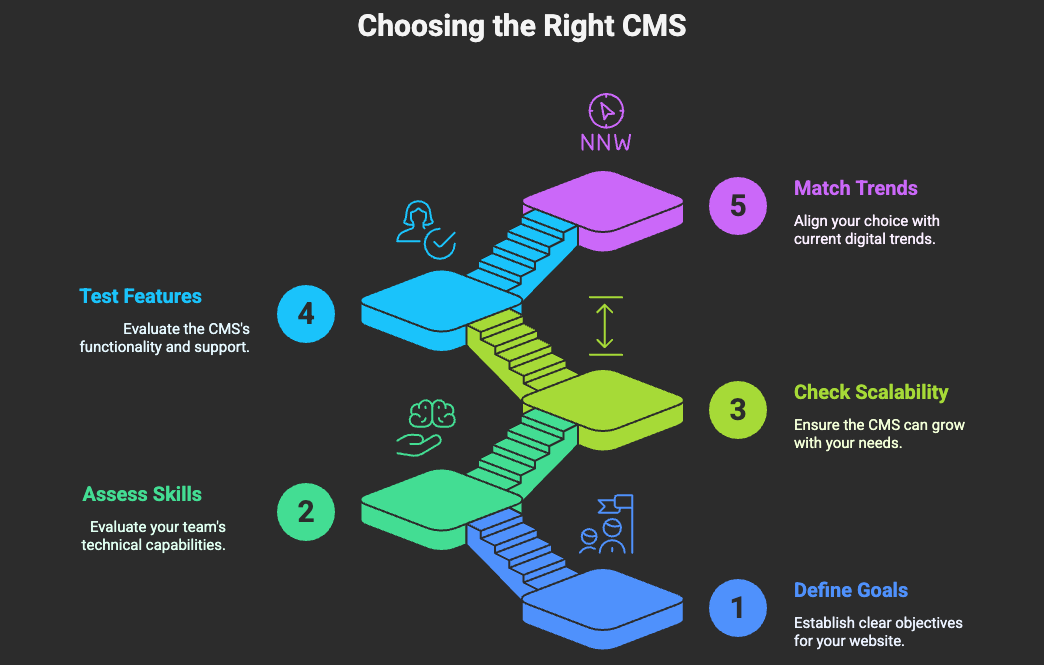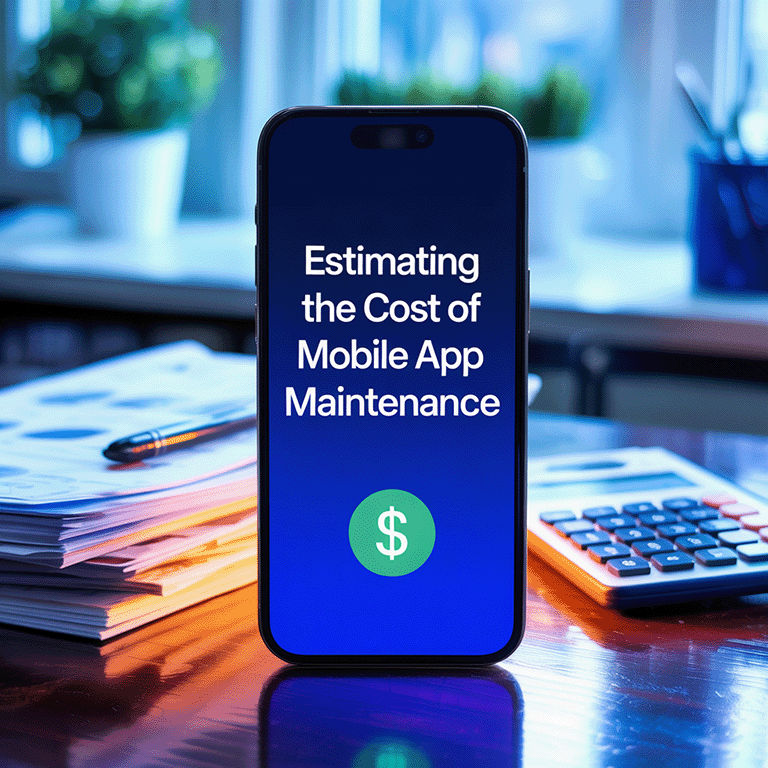What do you call a CMS that never loads fast, breaks every month, and eats your budget?
A real nightmare in code.
Now here’s a real question—Is your current CMS ready for 2025?
Because the web is not what it used to be. Your site isn’t just a set of pages anymore. It’s where sales start, leads convert, and users expect real-time answers. If your CMS can’t keep up, your growth takes the hit.
And you’re not alone in feeling the pressure. The global content management software market is projected to hit $23.17 billion by 2025, growing steadily at a 4.85% rate through 2029. That’s a lot of people betting big on the right tool.
So the question is—are you using the right CMS for what lies ahead? Keep reading to find out how to choose a content management system.
Why Your CMS Choice Matters More in 2025
Back in the day, websites just told your story. Now they sell, talk, and even think. The lines between tech, sales, and content are gone.
Shifting Landscape
A CMS isn’t just a tool now—it’s your backstage engine.
Think about this:
- Selling online? Your CMS needs product pages, payment tools, and speed.
- Running campaigns? You need AI tools, integrations, and fast content changes.
- Publishing often? SEO and mobile come first.
The wrong CMS will slow you down or cost you more to maintain. And fixing that later? Even more costly.
What’s at Stake
- User experience: A fast, smooth site keeps people clicking. One second too long and they bounce.
- Scalability: Will your CMS grow with your needs? Or choke when traffic spikes or more features are needed?
That’s why choosing a CMS platform is not just a tech task. It’s a strategic move—like hiring the right leader for your digital front line.
Key Trends Shaping CMS Choices in 2025
What you need in a CMS has changed. These trends will shape which CMS to choose:
| Trend | What It Means | Why It Matters |
| Headless CMS | Front-end and back-end work on their own | Makes it easy to run your site across web, app, and wearables |
| AI Integration | CMS comes with AI tools | Personalize content, plan posts, even automate updates |
| Low-Code Setup | Fewer lines of code needed | Fast launch, easier changes—helpful when you outsource coding |
| Sustainability | Green servers, lean code | Lower energy use, smaller carbon footprint |
| No-Code Builders | Drag and drop tools | Ideal if your team isn’t tech-heavy |
| Real-Time Previews | See changes live | Cuts back on errors and guesswork |
| Composable Architecture | Pick and swap tools freely | Lets you build what fits now and later |
These trends push CMS choices toward platforms that are flexible, smart, and lean. So, if you’re wondering how to choose the right CMS, start here—match your platform with today’s tech.
As CMS platforms evolve, many are incorporating built-in AI features to enhance content management and user experience. Some of the best AI website builders already offer smart tools for faster and more personalized site creation.
How to Choose the Right CMS: Your Step-by-Step Guide
So, how do you choose a website-building platform in 2025? Here’s a clear path:

Step 1: Define Your Goals
Start by asking:
- Is your site for e-commerce, blogging, or landing leads?
- Do you want to grow big or stay niche?
Example:
If you’re building an online store, you’ll want product pages, carts, and stock tools. But if it’s a blog? You’ll want SEO tools, fast search, clean reading experience.
Tip:
“How to choose a website platform” starts with knowing your ‘why.’
No clear goal = wrong CMS.
Step 2: Assess Your Team’s Skills
- Do you have coders on hand? You can go with complex platforms.
- No tech team? Choose low-code or no-code options.
Example:
A small agency with writers and marketers may use Wix or Webflow. But a tech startup with devs might go headless using Contentful.
Tie-in:
Outsourcing code development—via a tech team like LITSLINK—can help fill gaps. They can set up tricky platforms or help with custom tools.
Step 3: Check Scalability and Budget
You don’t want a CMS that breaks down as traffic grows—or one that drains your funds.
Ask:
- Can this CMS handle traffic spikes?
- What are the real costs? (Think license, add-ons, hosting, and dev hours)
Example:
Free CMS may sound good—but once you add plug-ins, the price jumps.
Think of the $51.89 average spend per employee in North America in 2025. It adds up.
Tip:
Choosing a content management system means thinking beyond just the setup cost.
Step 4: Test Features and Support
Some CMS tools look great—until you need help or updates.
Check for:
- Mobile-ready design
- Regular security updates
- Vendor or user community support
Tip:
Always try the demo version. If the editor feels hard now, it won’t get easier later.
Step 5: Match to Trends
Think of 2025. If you want your CMS to last, it needs to fit the world we’re moving into.
Ask yourself:
- Do I need AI content suggestions?
- Will I launch a mobile app too?
- Do I want to reduce my carbon footprint?
Tip:
How to choose the right CMS ties back to what’s hot now.
Need help setting it up? A team like LITSLINK can bridge that tech gap.
Choosing a CMS often goes hand in hand with rethinking your site’s structure and design. If you’re planning updates, it might be worth exploring key considerations in a website redesign.
Popular CMS Options in 2025: A Quick Rundown
Here’s a quick look at the top CMS picks for this year:
| CMS | Pros | Cons |
| WordPress | Flexible, huge plugin list, great for outsourcing tweaks | Can get slow or bloated if not trimmed |
| Shopify | Great for online shops, secure, fast | Less control for non-eCommerce content |
| Contentful | Future-proof, good for apps and multiple channels | Needs developers or outside help |
| Wix | Simple, drag-and-drop, fast launch | May not scale for big firms |
| Webflow | Great visuals, clean code, no-code builder | Limited backend flexibility |
| Joomla | More control than WordPress | Steeper learning curve |
| Drupal | Strong for complex sites | Needs deep tech skills |
Pitfalls to Avoid When Choosing a CMS
Mistakes happen when you’re not sure how to choose a content management system. Avoid these:
- Overcomplicating:
Don’t pick a system your team can’t run. If you must go advanced, outsourcing code development can help.
- Ignoring Costs:
Those “free” tools may charge for support, plug-ins, storage. Add it all up first.
- Skipping Updates:
Outdated CMS? Big risk. Hackers look for those. Make sure support lasts.
- Choosing Just by Trends:
Don’t chase shiny features you don’t need. Align trends with your goals.
- No Trial Run:
If you skip the demo, you may miss bugs, poor workflows, or missing features.
Reminder:
Choosing the right CMS is part gut, part guide. Use both.
Not every business needs a traditional website—some might benefit more from an app-like experience. Comparing a web app vs. a website can help you decide which format aligns best with your goals.
Conclusion: Your CMS, Your Future
The CMS you pick shapes your growth, speed, and how your brand looks to the world.
Let’s sum it up:
- Match your goals to your CMS.
- Know your team’s skills (or who you can call for help).
- Keep 2025 in mind—AI, headless, and fast setups matter now.
- Try before you buy.
- Don’t go it alone if you don’t have to.
The good news? The perfect CMS isn’t a myth—it’s out there, waiting to power your 2025 wins.
If you’re still not sure which way to go, LITSLINK can help with setup or coding support. Just a thought—but the right one could save you months of headaches.
If you’re unsure which CMS or tech stack fits your project, expert advice can go a long way.
Reach out through our contact page to talk with our team about the best options for your needs.





